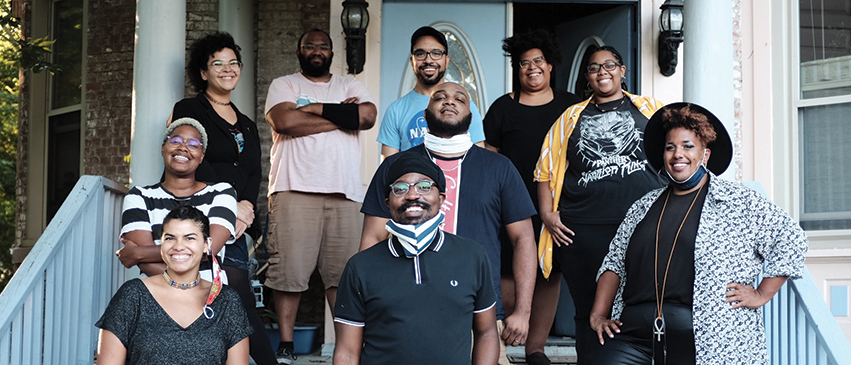
One hundred years ago, a social and artistic explosion was taking New York City by storm. As African Americans began to migrate from the rural South to urban spaces in the North, Harlem became a cultural mecca for Black artists, writers and intellectuals. Black music kicked off the Jazz Age, while Aaron Douglas’ groundbreaking Afro-centric artwork set the stage for young Black artists to enter the arts realm. Fighting rampant racism, their work also laid the foundation for the Civil Rights Movement.
The scope and influence of the Harlem Renaissance is remarkable on many levels, and it all started around 1918, even as a deadly strain of influenza was raging in a worldwide pandemic. A century later, amidst another global pandemic and nationwide protests for racial justice, local Black artists are working to create their own artistic movement—a Renaissance right here in Peoria.
Creating Space
Descending the porch steps of a spacious older home in Peoria’s North Valley, artist Brenda Gentry lights a citronella candle to keep the mosquitos at bay. It is a balmy summer evening, and a bright-yellow American goldfinch is perched on a flower deep in the foliage of the surrounding garden. Gentry positions her chair a short distance from fellow artist Alexander Martin, both wearing masks—a visual reminder that this moment in time is unlike any other in recent memory.
It is in this space—not just the temporal space that is 2020, but in the physical space of Gentry’s home and yard—that the roots of Peoria’s new Black Artists Guild began to take shape. The tendency to be asked to participate only in themed exhibits, both artists agree, was a driving factor. “We were tired of only showing with each other, or when somebody needed a Black History Month show—or an LGBTQ+ centered show,” Martin explains.
With the onset of the COVID-19 pandemic and the massive protests that swept the nation following the tragic murders of Ahmaud Arbery, Breonna Taylor and George Floyd, Gentry and Martin also began to notice a shift in thinking locally. “The Black community has known about the injustices facing our community forever,” Martin observes. “But we saw other people, in regard to the more recent protests and tragic events, being tuned into that and actually paying attention and listening.”
Gentry and Martin wanted to create a space where they could build on this momentum, dismantle the limitations of typecasting, and elevate the voices of more Black artists. “We’re fortunate to have established Black artists who are doing really awesome stuff in the community,” Martin notes. “We wanted to get a younger group [together]… people who aren’t as well represented in the community.”
Casting a net out to local Black creatives, the need for just such a group was made clear. “We posted a photo after our first meeting because we were very energized,” Martin reflects. “It was a very cathartic moment, all of us in one room, talking about our experiences of being artists and being Black in the Peoria community—and what we feel like we’re lacking.”
Their fellow artists arrived with a wide range of interests and specialties, from visual arts to spoken word to music and beyond. In the future, the Black Artists Guild hopes to involve designers, actors and anyone else who falls under the creative/artistic umbrella. And while Gentry and Martin are somewhat more established than many of the other members, they see themselves less as mentors than as fellow collaborators on parallel journeys. “Each one of us has different skills and knowledge,” Gentry suggests, “to be able to share our individual knowledge… and work on supporting and establishing each other together.”
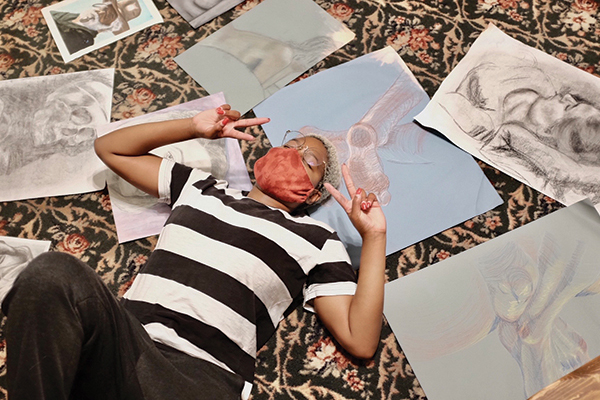
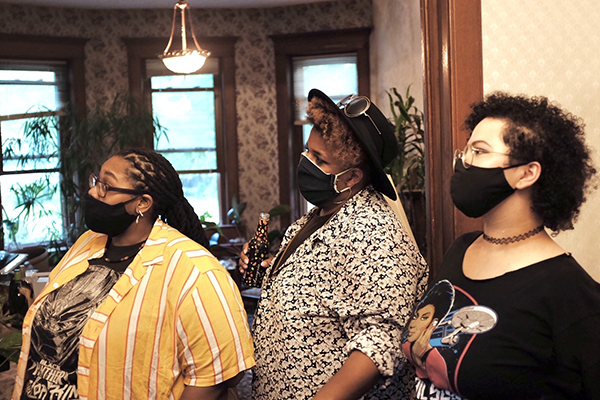
Normalizing Black Voices
The two artists have long been aware of the lack of diversity in Peoria’s arts scene. Last year, when Martin curated a show of Black artists for Peoria Proud, they observed the nervousness expressed by a Black family upon their arrival. “There were a lot of white folk in the space, but [fellow artist] Morgan Mullen got them to come in. I talked to the kids who grew up in Peoria and really liked the arts, but they hadn’t seen Black artists.” It was a disheartening reminder of the significant cultural divide, which mirrors the larger national problem. “You see a lot of art openings in a very white space, but you don’t see a lot of people who look like you there.”
In the Black community, Martin explains, involvement in the arts is not always a priority—not out of choice, but out of necessity. “It’s not necessarily practical for a community that has to fight to exist. You don’t really have time for that. To instill value in the arts, it has to happen on multiple levels.” They hope the Black Artists Guild can reach out to Black youth in Peoria and expand the scope of possibilities.
As for the local arts community, they suggest self-examination through a wider lens that considers these cultural complexities. “I think when you see people of color being successful in your community, it’s really easy to highlight that and prop them up… like, ‘Oh, we fixed the racism problem—we have so many successful Black artists!’ But where are the Black people coming to the events?” The arts are not immune to systemic racism, and this hurts everyone, Martin suggests. Reaching out to communities of color is a necessary start, but it’s not enough on its own. “You have to instill trust.”
Arts groups should take a closer look at why those populations aren’t in attendance, Martin continues. “Why do those reasons exist? It’s a weird headspace to navigate,” they say, admitting that the answers are elusive. “But I think just asking those questions, not being afraid to mess up, and acknowledging there’s a problem is important. And then just support! I think those are the easiest steps to take first. There’s a lot more to undoing systematic racism in general, but I think in the arts… uplifting Black voices, listening and learning are the biggest ones.”
“And also,” Martin adds with a chuckle, “please work with us in the other months besides February [Black History Month]! Those spotlights are good educational moments, but we need to normalize Black voices in all contexts.”
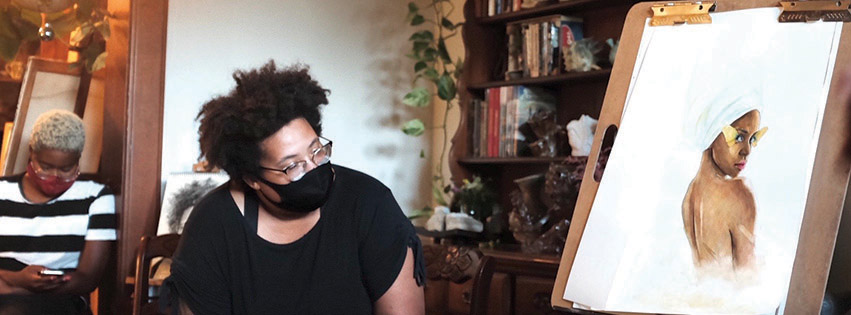
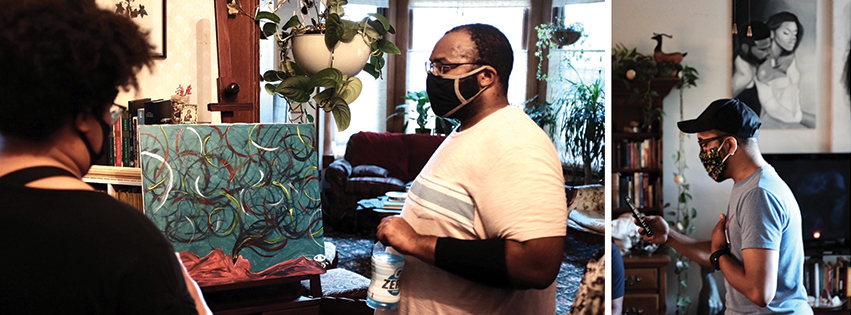
A Sense of Belonging
By offering up her home, Gentry has helped create a space where Black artists can draw support and feel connected. “I wanted to share our resources—there is a space here and I would love it to be utilized,” she says. And by working with artists who share similar backgrounds, they can focus more intently on their art.
“If I’m making work about identity and ethnicity, being biracial or anything else, it’s a different conversation with artists of color than it is in a predominantly white space,” Martin explains. “I don’t have to give a history lesson. I don’t have to explain what it feels like to be stereotyped or tokenized.”
While the group’s plans are still fluid, they intend to offer a variety of workshops and post educational videos. They are also launching a website with a directory of Black artists and creatives in the Peoria area, along with links to helpful resources. As the local arts scene—and the community at large—strives to become more inclusive, Martin and Gentry hope to ensure the artists are protected. “We want to be a support system to make sure that’s being done right,” Martin notes. “We want to make sure that those artists are represented well and getting paid, and are not just being tokenized.”
In forming the Black Artists Guild, Martin and Gentry hope their fellow Black artists can find a sense of belonging. “It’s our community space. This is our chance to support and uplift,” Martin explains. “We have so many people talking about insecurity and things we’ve all gone through individually—but talking about it together. And having the space to share that… it just feels really good!”
Just as the Harlem Renaissance grew out of larger social and cultural changes, Peoria’s Black Artists Guild is an extension of the national condition. Martin observes that their own gatherings feel similar to what happened in that explosion of creativity a century ago. “Seeing all these Black artists and voices just getting together, hanging out at someone’s house and making work—everyone else be damned—and then really awesome work coming out of it,” they note.
“There’s a lot happening in the arts in Peoria, and now people are more tuned in to issues of race. They’re listening! The current state of chaos in the world aside, I feel very optimistic about what changes and growth can happen,” Martin continues. “It reminds me a lot of the Harlem Renaissance and the stuff they were doing, making and showing. We are very inspired by that… we’ll bring a Peoria Black Renaissance!” PM
To learn more about the Black Artists Guild, visit PeoriaGoBA.com.
- Log in to post comments

